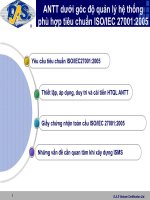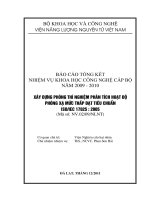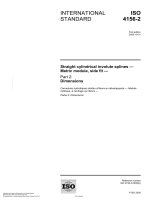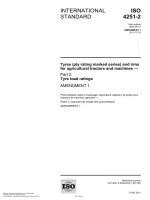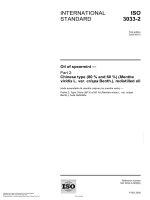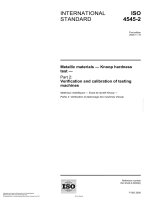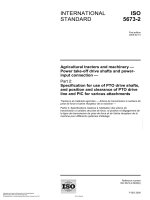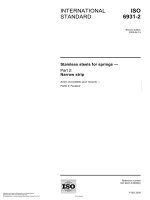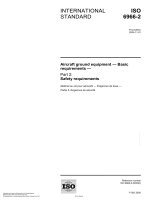Tiêu chuẩn iso 00857 2 2005
Bạn đang xem bản rút gọn của tài liệu. Xem và tải ngay bản đầy đủ của tài liệu tại đây (925.79 KB, 36 trang )
ISO
857-2
INTERNATIONAL
STANDARD
First edition
2005-11-01
Welding and allied processes —
Vocabulary —
Part 2:
Soldering and brazing processes and
related terms
Soudage et techniques connexes — Vocabulaire —
--`,,```,,,,````-`-`,,`,,`,`,,`---
Partie 2: Termes relatifs aux procédés de brasage tendre et de brasage
fort
Reference number
ISO 857-2:2005(E)
Copyright International Organization for Standardization
Reproduced by IHS under license with ISO
No reproduction or networking permitted without license from IHS
© ISO 2005
Not for Resale
ISO 857-2:2005(E)
PDF disclaimer
This PDF file may contain embedded typefaces. In accordance with Adobe's licensing policy, this file may be printed or viewed but
shall not be edited unless the typefaces which are embedded are licensed to and installed on the computer performing the editing. In
downloading this file, parties accept therein the responsibility of not infringing Adobe's licensing policy. The ISO Central Secretariat
accepts no liability in this area.
Adobe is a trademark of Adobe Systems Incorporated.
Details of the software products used to create this PDF file can be found in the General Info relative to the file; the PDF-creation
parameters were optimized for printing. Every care has been taken to ensure that the file is suitable for use by ISO member bodies. In
the unlikely event that a problem relating to it is found, please inform the Central Secretariat at the address given below.
--`,,```,,,,````-`-`,,`,,`,`,,`---
© ISO 2005
The reproduction of the terms and definitions contained in this International Standard is permitted in teaching manuals, instruction
booklets, technical publications and journals for strictly educational or implementation purposes. The conditions for such reproduction are:
that no modifications are made to the terms and definitions; that such reproduction is not permitted for dictionaries or similar publications
offered for sale; and that this International Standard is referenced as the source document.
With the sole exceptions noted above, no other part of this publication may be reproduced or utilized in any form or by any means,
electronic or mechanical, including photocopying and microfilm, without permission in writing from either ISO at the address below or
ISO's member body in the country of the requester.
ISO copyright office
Case postale 56 • CH-1211 Geneva 20
Tel. + 41 22 749 01 11
Fax + 41 22 749 09 47
Web www.iso.org
Published in Switzerland
ii
Copyright International Organization for Standardization
Reproduced by IHS under license with ISO
No reproduction or networking permitted without license from IHS
© ISO 2005 – All rights reserved
Not for Resale
ISO 857-2:2005(E)
Contents
Page
Foreword............................................................................................................................................................. v
Introduction ....................................................................................................................................................... vi
1
Scope ........................................................................................................................................................... 1
2
Normative references ................................................................................................................................. 1
3
Terms and definitions ................................................................................................................................ 1
Annex A (informative) Process descriptions based on energy sources ...................................................... 9
A.1 Soldering ..................................................................................................................................................... 9
A.2 Brazing....................................................................................................................................................... 16
Annex B (informative) List of equivalent English, French and German terms for brazing
and soldering processes ......................................................................................................................... 24
Alphabetical index ........................................................................................................................................... 28
--`,,```,,,,````-`-`,,`,,`,`,,`---
iii
© ISO 2005 – All rights reserved
Copyright International Organization for Standardization
Reproduced by IHS under license with ISO
No reproduction or networking permitted without license from IHS
Not for Resale
ISO 857-2:2005(E)
Foreword
ISO (the International Organization for Standardization) is a worldwide federation of national standards bodies
(ISO member bodies). The work of preparing International Standards is normally carried out through ISO
technical committees. Each member body interested in a subject for which a technical committee has been
established has the right to be represented on that committee. International organizations, governmental and
non-governmental, in liaison with ISO, also take part in the work. ISO collaborates closely with the
International Electrotechnical Commission (IEC) on all matters of electrotechnical standardization.
International Standards are drafted in accordance with the rules given in the ISO/IEC Directives, Part 2.
The main task of technical committees is to prepare International Standards. Draft International Standards
adopted by the technical committees are circulated to the member bodies for voting. Publication as an
International Standard requires approval by at least 75 % of the member bodies casting a vote.
Attention is drawn to the possibility that some of the elements of this document may be the subject of patent
rights. ISO shall not be held responsible for identifying any or all such patent rights.
ISO 857-2 was prepared by Technical Committee ISO/TC 44, Welding and allied processes, Subcommittee
SC 7, Representation and terms.
Together with ISO 857-1, this part of ISO 857 cancels and replaces ISO 857:1990, which has been technically
revised.
ISO 857 consists of the following parts, under the general title Welding and allied processes — Vocabulary:
Part 1: Metal welding processes
Part 2: Soldering and brazing processes and related terms
--`,,```,,,,````-`-`,,`,,`,`,,`---
iv
Copyright International Organization for Standardization
Reproduced by IHS under license with ISO
No reproduction or networking permitted without license from IHS
© ISO 2005 – All rights reserved
Not for Resale
ISO 857-2:2005(E)
Introduction
ISO 857:1990 has been revised in two new parts, ISO 857-1, Welding and allied processes — Vocabulary —
Part 1: Metal welding processes, and ISO 857-2, Welding and allied processes — Vocabulary — Part 2:
Soldering and brazing processes and related terms.
ISO 857-1 is restricted to welding processes for metallic materials and the welding processes are structured in
a more systematic way than in ISO 857:1990. The processes have been classified according to their physical
characteristics, e.g. pressure or fusion welding, and the type of energy source. A number of new processes
have been added and a number of obsolete processes have been removed.
ISO 857-2 is restricted to soldering and brazing processes and is organized in the same manner as
ISO 857-1. New definitions have been added in order to provide a better understanding of such processes.
The numbers in parentheses following the name of the process refer to the numbering used in ISO 4063. Most
of the definitions are accompanied by schematic figures given as examples.
Requests for official interpretations of any aspect of this part of ISO 857 should be directed to the Secretariat
of ISO/TC 44/SC 7 via your national standards body. A complete listing of these bodies can be found at
www.iso.org.
--`,,```,,,,````-`-`,,`,,`,`,,`---
v
© ISOfor2005
– All rights reserved
Copyright International Organization
Standardization
Reproduced by IHS under license with ISO
No reproduction or networking permitted without license from IHS
Not for Resale
--`,,```,,,,````-`-`,,`,,`,`,,`---
Copyright International Organization for Standardization
Reproduced by IHS under license with ISO
No reproduction or networking permitted without license from IHS
Not for Resale
INTERNATIONAL STANDARD
ISO 857-2:2005(E)
Part 2:
Soldering and brazing processes and related terms
1
Scope
--`,,```,,,,````-`-`,,`,,`,`,,`---
Welding and allied processes — Vocabulary —
This part of ISO 857 defines terms used for metal soldering and brazing processes, as well as related terms.
2
Normative references
The following referenced documents are indispensable for the application of this document. For dated
references, only the edition cited applies. For undated references, the latest edition of the referenced
document (including any amendments) applies.
ISO 4063, Welding and allied processes — Nomenclature of processes and reference numbers
3
Terms and definitions
3.1
soldering/brazing
joining processes in which a molten filler material is used that has a lower liquidus temperature than the
solidus temperature of the parent material(s), which wets the surfaces of the heated parent material(s) and
which, during or after heating, is drawn into (or, if pre-placed, is retained in) the narrow gap between the
components being joined
NOTE 1 These processes are generally carried out with metals but they can also be carried out with non-metallic
materials. The filler material always has a different chemical composition from the components being joined.
NOTE 2
If the process is carried out without capillary attraction, it is often described as braze welding.
3.1.1
soldering
joining process using filler metal with a liquidus temperature of 450 °C or less
3.1.2
brazing
joining process using filler metal with a liquidus temperature above 450 °C
3.1.3
coating
deposition of a layer or layers of material on a surface to obtain desired properties and/or dimensions
3.1.4
filler metal spreading and gap filling
3.1.4.1
wetting
spreading and adhesion of a thin continuous layer of molten filler metal on the surfaces of the components
being joined
1
© ISO 2005 – All rights reserved
Copyright International Organization for Standardization
Reproduced by IHS under license with ISO
No reproduction or networking permitted without license from IHS
Not for Resale
ISO 857-2:2005(E)
3.1.4.2
de-wetting
separation of solid filler material which, although it had spread over the surfaces of the components to be
joined, had failed to bond to them because of e.g. inadequate cleaning or fluxing
3.1.4.4
capillary attraction
force, caused by surface tension, which draws the molten filler metal into the gap between the components
being joined, even against the force of gravity
3.1.4.5
bonding process
process by which a bond is created between the liquid phase of the filler metal and the solid parent metal due
to metallurgical reaction
3.2
materials for soldering or brazing
3.2.1
filler metal
added metal required for soldered or brazed joints, which can be in the form of wire, inserts, powder, pastes,
etc.
3.2.2
flux
non-metallic material which, when molten, promotes wetting by removing existing oxide or other detrimental
films from the surfaces to be joined and prevents their re-formation during the joining operation
3.2.3
binder
substance with which filler metals and/or fluxes are bound as powders or pastes so that they can be applied to
the joint as paste or can be moulded into filler metal shapes
3.2.4
soldering and brazing stop-off
substance used to prevent undesirable spreading of molten filler metal
3.2.5
parent material
material being brazed/soldered
3.2.6
protective atmosphere for soldering or brazing
gas atmosphere or vacuum round a component, either to remove oxide or other detrimental films on the
surfaces to be joined or to prevent the re-formation of such films on surfaces which have previously been
cleaned
3.2.6.1
reducing gas atmosphere
gas which reduces oxides owing to its high affinity for oxygen
3.2.6.2
inert gas atmosphere
gas which prevents the formation of oxides during the soldering or brazing process
2
Copyright International Organization for Standardization
Reproduced by IHS under license with ISO
No reproduction or networking permitted without license from IHS
© ISO 2005 – All rights reserved
Not for Resale
--`,,```,,,,````-`-`,,`,,`,`,,`---
3.1.4.3
flow path
distance through which the molten filler metal flows in the joint
ISO 857-2:2005(E)
--`,,```,,,,````-`-`,,`,,`,`,,`---
3.2.6.3
vacuum
pressure sufficiently below atmospheric so that the formation of oxides will be prevented to a degree sufficient
for satisfactory soldering or brazing, because of the low partial pressure of the residual gas
NOTE As a vacuum can only eliminate oxides to a very limited extent, preparatory cleaning of the surfaces to be wetted
is of the greatest importance.
3.3
process conditions
3.3.1
characteristic temperatures
3.3.1.1
melting temperature range of the filler metal
temperature range extending from the commencement of melting (solidus temperature) to complete
liquefaction (liquidus temperature)
NOTE
Some filler metals have a melting point rather than a melting range.
3.3.1.2
soldering or brazing temperature
temperature at the joint where the filler metal wets the surface or where a liquid phase is formed by boundary
diffusion and there is sufficient material flow
NOTE
With some filler metals, this is below the liquidus temperature of the filler metal.
3.3.1.3
equalizing temperature
preheating temperature
temperature at which the components being joined are held so that they are uniformly heated through
NOTE
It is lower than the solidus temperature of the filler metal.
3.3.1.4
effective temperature range
temperature range within which a flux or a protective atmosphere is effective
3.3.2
characteristic times
3.3.2.1
soldering or brazing time
time period for the soldering or brazing cycle
3.3.2.2
heating time
time during which the soldering or brazing temperature is reached
NOTE
It includes the equalizing (preheating) time and can also include other times, e.g. the degassing time.
3.3.2.3
equalizing time
preheating time
time during which the components to be soldered or brazed are held at the equalizing/preheating temperature
3.3.2.4
holding time
time during which the joint is kept at the soldering or brazing temperature
3
© ISO 2005 – All rights reserved
Copyright International Organization for Standardization
Reproduced by IHS under license with ISO
No reproduction or networking permitted without license from IHS
Not for Resale
ISO 857-2:2005(E)
3.3.2.5
cooling time
time during which the joint cools down from the soldering or brazing temperature to ambient temperature
NOTE
It can include the time necessary for the post heat treatment of the soldered or brazed parts.
3.3.2.6
total time
period which includes the heating time, the holding time and the cooling time
3.3.2.7
effective time
time during which the flux remains effective during the soldering or brazing operation
NOTE
It is dependent on the procedure used.
3.4
soldering or brazing geometry
3.4.1
closed joint
joint in which the gap is filled principally by capillary action with filler metal, i.e. either a butt joint or a lap joint
between parallel faces of the components to be soldered or brazed
NOTE 1
See Figures 1 and 2.
NOTE 2
The lap width and length determine the area over which the components will be joined.
NOTE 3 For soldering/brazing with radiation and soldering/brazing with an electric arc, mixtures of joint types, i.e. butt
weld at raised edge or butt weld at lap joint, are also possible.
Key
1
2
closed joint length
closed joint width (assembly gap)
3
component thickness
Figure 1 — Closed butt joint
4
Copyright International Organization for Standardization
Reproduced by IHS under license with ISO
No reproduction or networking permitted without license from IHS
--`,,```,,,,````-`-`,,`,,`,`,,`---
Not for Resale
© ISO 2005 – All rights reserved
ISO 857-2:2005(E)
Key
1
2
closed joint length
closed joint width (assembly gap)
3
4
lap length
component thickness
Figure 2 — Closed lap joint
3.4.2
open joint
joint in which the gap is filled with filler metal by gravity
NOTE 1
See Figure 3, which shows two components with parallel faces prepared for soldering or brazing.
NOTE 2
This process is often described as braze welding.
NOTE 3 For soldering/brazing with radiation and soldering/brazing with an electric arc, mixtures of joint types, i.e. butt
weld at raised edge or butt weld at lap joint, are also possible.
Key
1 open joint length
2
3
open joint width (assembly gap)
component thickness
Figure 3 — Open butt joint (square butt joint)
3.4.3
soldering or brazing gap
narrow, mainly parallel gap between the components to be soldered or brazed, measured at the soldering or
brazing temperature
--`,,```,,,,````-`-`,,`,,`,`,,`---
5
© ISO 2005 – All rights reserved
Copyright International Organization for Standardization
Reproduced by IHS under license with ISO
No reproduction or networking permitted without license from IHS
Not for Resale
ISO 857-2:2005(E)
3.4.4
assembly gap
narrow, mainly parallel gap between the components to be soldered or brazed, measured at room
temperature
3.5
soldered/brazed assemblies
Terms relating to soldered/brazed assemblies are illustrated in Figures 4 and 5.
Terms relating to
components
Terms relating to
materials
soldered/brazed assembly/component
I
parent material zone
II
soldered/brazed joint
III
heat-affected zone
IV
soldering/brazing seam
V
diffusion/transition zone
VI
solder/braze metal zone
VII
parent material
1
parent material affected by the soldering/brazing process
2
diffusion/transition zone
3
solder/braze metal
4
--`,,```,,,,````-`-`,,`,,`,`,,`---
Figure 4 — Terms relating to components and materials in soldered/brazed assemblies
6
Copyright International Organization for Standardization
Reproduced by IHS under license with ISO
No reproduction or networking permitted without license from IHS
© ISO 2005 – All rights reserved
Not for Resale
ISO 857-2:2005(E)
Key
1
Material
parent material
Assembly
IV heat-affected zone
2
3
parent material affected by the soldering/brazing process V
diffusion/transition zone
4
solder/braze metal
soldering/brazing seam
t
Dimensions
component thickness
J
W
effective joint width
lap length
Figure 5 — Schematic diagram of a soldered/brazed joint
3.5.1
assembly
3.5.1.1
soldered or brazed assembly
assembly formed by soldering or brazing two or more components together
An assembly may subsequently become a component in another, larger, assembly.
3.5.1.2
soldering or brazing seam
region of the joint comprising the solder/braze material and the diffusion/transition zones
3.5.1.3
heat-affected zone
zone of parent materials affected by the soldering/brazing process
--`,,```,,,,````-`-`,,`,,`,`,,`---
NOTE
3.5.2
materials
3.5.2.1
parent material affected by the soldering/brazing process
material with properties different from those of the parent material due to the influence of the soldering/brazing
process
7
© ISO 2005 – All rights reserved
Copyright International Organization for Standardization
Reproduced by IHS under license with ISO
No reproduction or networking permitted without license from IHS
Not for Resale
ISO 857-2:2005(E)
3.5.2.2
diffusion zone
transition zone
layers formed during soldering or brazing with a chemical composition that is different from that of the parent
material(s) and that of the solder or braze metal
3.5.2.3
solder or braze metal
metal formed by the soldering or brazing process
NOTE Because the filler metal has melted, its chemical composition may change due to reactions with the parent
material(s).
3.6
soldering/brazing procedures
3.6.1
manual soldering or brazing
soldering or brazing in which all operations are carried out manually
3.6.2
mechanized soldering or brazing
soldering or brazing in which all the main operations, except the handling of the workpiece, are carried out
mechanically
3.6.3
automatic soldering or brazing
soldering or brazing in which all operations, including all auxiliary operations such as changing the workpiece,
are carried out automatically
3.6.4
soldering and brazing with filler metal applied
process during which the components are heated up to the soldering or brazing temperature in the area of the
joint, and the filler metal is brought to its melting point mainly by contact with the components to be soldered or
brazed
3.6.5
soldering or brazing with filler metal inserted
process during which the filler metal is placed in the area of the joint before heating, and is then heated to the
soldering or brazing temperature together with the components to be soldered or brazed
3.6.7
soldering or brazing with components coated with filler metal
process during which the filler metal is applied before soldering/brazing by coating (e.g. by plating, electrocoating
or vapour deposition)
8
Copyright International Organization for Standardization
Reproduced by IHS under license with ISO
No reproduction or networking permitted without license from IHS
© ISO 2005 – All rights reserved
Not for Resale
--`,,```,,,,````-`-`,,`,,`,`,,`---
3.6.6
dip soldering or brazing
process during which the components to be soldered or brazed are dipped in a bath of molten salt, molten flux or
molten filler metal
ISO 857-2:2005(E)
Annex A
(informative)
Process descriptions based on energy sources
(numbers in parentheses refer to ISO 4063)
A.1 Soldering
A.1.1 Soldering with solid heat-supply media
A.1.1.1 Soldering with soldering iron (952)
See Figure A.1.
Heating the soldering point and melting the filler metal are carried out using a soldering iron operated
manually or mechanically. A soldering iron with a heat capacity, shape and tip suitable for the soldering point
is used. Both of the components to be joined and the filler metal are brought to the brazing/soldering
temperature using a flux, either separately or in the form of a flux-cored filler metal.
Key
1 tip of soldering iron
2
3
flux-cored solder
printed-circuit board
4
conductor
Figure A.1 — Examples of soldering with a soldering iron (printed-circuit board)
A.1.1.2 Soldering with preheated blocks (96)
The components are brought to the soldering temperature by heat from a heated metal block (e.g. a hotplate).
The filler metal is usually applied in the form of flux-cored filler metal or as solid wire. In the latter case, flux is
applied to the joint beforehand. This process is of importance in soldering thick workpieces to thinner sheetmetal components.
--`,,```,,,,````-`-`,,`,,`,`,,`---
9
© ISO 2005 – All rights reserved
Copyright International Organization for Standardization
Reproduced by IHS under license with ISO
No reproduction or networking permitted without license from IHS
Not for Resale
ISO 857-2:2005(E)
A.1.1.3 Roller tinning (96)
See Figure A.2.
The surface is heated by a roller turning in liquid filler metal, which is thus wetted with filler metal. Flux is
applied to the surface beforehand. The solder is thus made to flow over the surface.
Key
1 flat component (e.g. printed-circuit board)
2
3
counter-roller
soldering roller
4
5
layer of salts to protect filler metal in bath
filler metal bath
Figure A.2 — Roller tinning
A.1.2 Soldering with liquids
A.1.2.1 Dip soldering (944)
See Figure A.3.
The components are soldered by dipping them in a bath of liquid filler metal. They are wetted with flux before
dipping. The dipping speed is selected so that it is just high enough to ensure that each component reaches
the soldering temperature during dipping. A visible sign of this is the presence of a positive meniscus
(concave surface) at the interface between the filler metal surface and the component.
The component to be soldered may be either cold or preheated before dipping.
--`,,```,,,,````-`-`,,`,,`,`,,`---
10
Copyright International Organization for Standardization
Reproduced by IHS under license with ISO
No reproduction or networking permitted without license from IHS
© ISO 2005 – All rights reserved
Not for Resale
ISO 857-2:2005(E)
Key
1
2
positive meniscus (concave surface)
component
3
filler metal bath
Figure A.3 — Dip soldering
A.1.2.2 Wave soldering (951)
See Figure A.4.
The liquid filler metal is applied by a solder wave produced by a pump and a nozzle. This process is mainly
used, in conjunction with a wave or spray fluxer and a flux dryer, to solder printed circuits. It is desirable to use
a feed angle of about 7° between the surface of the bath and the printed circuits.
Key
1
2
printed-circuit board
dryer
3
4
filler metal bath with solder wave
wave or spray fluxer (flux with foam wave)
a
Feed angle.
Figure A.4 — Wave soldering
--`,,```,,,,````-`-`,,`,,`,`,,`---
11
© ISOfor2005
– All rights reserved
Copyright International Organization
Standardization
Reproduced by IHS under license with ISO
No reproduction or networking permitted without license from IHS
Not for Resale
ISO 857-2:2005(E)
A.1.2.3 Drag soldering (956)
See Figure A.5.
The filler metal bath used has a large surface area but is very shallow. The surfaces of the flat components
being soldered (printed-circuit boards) are first wetted with flux and dried. The printed-circuit boards are then
immersed in the bath: the run-in and run-out angles may be the same or different (e.g. 8° to 10°) and the
depth of immersion about half the circuit-board thickness. A rigid strip mounted immediately in front of the
circuit board removes oxide from the surface of the filler metal bath as the circuit board moves through the
bath. The soldering time is determined by the speed of the circuit boards and the length of the filler metal bath.
Key
1
2
rigid strip
holder
3
4
printed-circuit board
filler metal bath
5
6
dryer
wave or spray fluxer (flux with foam wave)
Figure A.5 — Drag soldering
--`,,```,,,,````-`-`,,`,,`,`,,`---
12 Organization for Standardization
Copyright International
Reproduced by IHS under license with ISO
No reproduction or networking permitted without license from IHS
© ISO 2005 – All rights reserved
Not for Resale
ISO 857-2:2005(E)
A.1.2.4 Ultrasonic soldering (947)
See Figure A.6.
The area to be soldered of the component is dipped into a heated bath of liquid filler metal. This area is then
freed from oxide by the action of a sonotrode, the cavitation occurring at the metal breaking up and detaching
oxide layers. To avoid shadow effects, it is convenient to have a two-sided arrangement (two sonotrodes
placed opposite each other). In this way, the clean metal (e.g. aluminium) can be tinned without the use of
flux.
Key
1
component
2
3
utrasonic generator
sonotrode
4
5
support structure with cooling fan
base
6
filler metal bath
Figure A.6 — Ultrasonic soldering
--`,,```,,,,````-`-`,,`,,`,`,,`---
13
© ISO 2005 – All rights reserved
Copyright International Organization for Standardization
Reproduced by IHS under license with ISO
No reproduction or networking permitted without license from IHS
Not for Resale
ISO 857-2:2005(E)
A.1.3 Soldering with gases
A.1.3.1 Flame soldering (942)
See Figure A.7.
Heat is supplied by combustion of a gaseous fuel. The flame is not applied directly on to the fluxed joint
because this would damage the flux. The joint area is kept evenly heated by movement of the blowpipe. The
filler metal is either laid between the components or fed in when the soldering temperature is reached.
Key
1
2
flux and filler metal
components
3
flame
Figure A.7 — Flame soldering
A.1.3.2 Hot gas soldering (96)
--`,,```,,,,````-`-`,,`,,`,`,,`---
Air is heated either by passing it through an electric heater or by burning it in a flame, and the hot
air/combustion gases blown through a nozzle on to the components to be soldered. The filler metal is placed
between the components after application of the flux, or it is fed in after the soldering temperature has been
reached. Other gases may be used instead of air.
A.1.4 Infrared soldering (941)
An infrared light source, located at the focal point of a semi-elliptical mirror, is used. The emitted rays are
focused at the second focal point where they impinge on the component to be soldered, to which the filler
metal and flux have already been applied. Most metal components reflect part of the incident radiant energy at
their surface, the rest being converted into heat at a depth of few micrometres.
A.1.5 Soldering using an electric current
A.1.5.1 Induction soldering in air (946)
After the components to be joined have been treated with flux and filler metal, the heat necessary for soldering
is generated in the component by an induced alternating current. The filler metal is then introduced between
the components, or it is fed in when the soldering temperature has been reached. The soldering is carried out
in air.
14
Copyright International Organization for Standardization
Reproduced by IHS under license with ISO
No reproduction or networking permitted without license from IHS
© ISO 2005 – All rights reserved
Not for Resale
